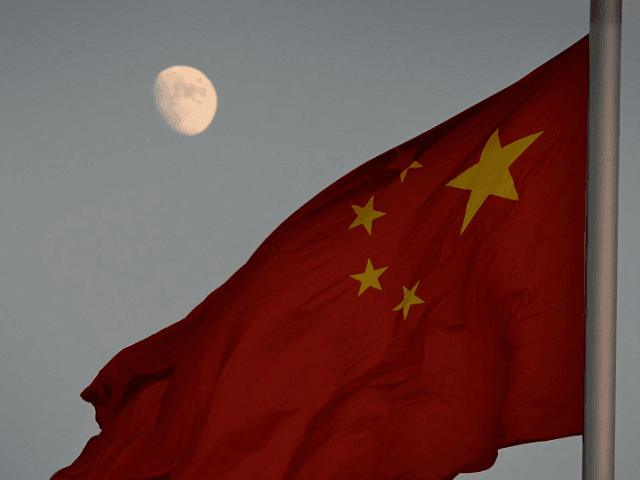The Russian space agency Roscosmos announced on Tuesday that it is “seriously considering” building a nuclear power plant on the moon in collaboration with the communist government of China.
The CEO of the agency, Yury Borisov, claimed that the project could be completed as recently as the year 2033 if Roscosmos and the China National Space Administration (CNSA) succeed in developing a plan for robots to build the reactor on the moon and devising a “space tugboat” that could ship reactor materials, coolants, and other critical cargo to and from the facility.
“Today, we are seriously considering a project to deliver to the Moon and mount a power reactor there jointly with our Chinese partners somewhere between 2033 and 2035,” Borisov said on Tuesday, according to the Russian news agency Tass. Borisov was reportedly speaking to Russian students at the World Youth Festival.
The Iranian state media outlet PressTV, covering the event, said that Borisov explained that nuclear power would be required for any future moon colony or research facility as the amount of solar power that scientists can generate on the moon would not be enough to sustain a large building. The harsh conditions on the moon would also mean that construction of the nuclear power plant “should be done in automatic mode, without the presence of humans” by robots.
Transport of materials also poses a significant challenge, he reportedly added.
“We are indeed working on a space tugboat,” Borisov was quoted as explaining. “This huge, cyclopean structure that would be able, thanks to a nuclear reactor and high-power turbines … to transport large cargoes from one orbit to another, collect space debris and engage in many other applications.”
Borisov had previously announced the development of a “space tug” he referred to as “Zevs” in April.
“We expect to implement it in practice by 2030. This is one of many products that will aid us in the expansion to the Moon, we plan to use in the joint project with China,” Borisov suggested at the time.
The plan to erect a nuclear power plant on the moon appears to be the result of an agreement between China and Russia announced in November to collaborate on lunar projects specifically. At the time of its announcement, the Chinese state propaganda outlet the Global Times dismissed Russia’s space projects as “relatively lackluster,” noting the recent failure of the country’s Luna-25 spacecraft mission. Luna-25 was expected to be the first Russian vessel to land on the moon in 47 years, but failed its landing, crashing into the surface of the moon instead.
The agreement in November to collaborate on a lunar project followed an announcement in 2022 by Roscosmos that the agency was interested in a moon landing project with Beijing, a potential extension of an already existing 2017 agreement on moon research. Following the November agreement, the Global Times appeared optimistic that the project was possible, but not because of the perceived competence of the Russians.
“Russia’s space development has been relatively lackluster, with a shortage of talent and resources in the aerospace field,” the Chinese regime outlet declared. “This is the part where China can fill in this gap, with its abundant economic resources as well as engineering resources.”
The state-owned China Aerospace Science and Technology Corp (CASC) announced on Monday, the first day of China’s “two sessions” of rubber-stamp legislative bodies meeting, that the Communist Party had planned a variety of new space projects for the near future, but excluded mention of any joint projects with Russia.
“To be specific, two cargo spacecraft launching missions – Tianzhou -7, -8, two crewed spacecraft launch missions – Shenzhou-18, -19, have been scheduled for the year of 2024,” the Global Times reported, citing the CASC, “and two crewed return missions for Shenzhou-17 and -18 will be also executed.”
Russia has distanced its space development from America and the greater West in recent years in response to mounting sanctions meant to deter its ongoing invasion of neighboring Ukraine. In 2022, the Russian government announced that it would not longer collaborate on the International Space Station (ISS) project in light of the sanctions, but that it would not fully withdraw from the ISS until 2024. Borisov said at the time that Russia was considering building its own independent space facility to continue similar research.
The Russia segment of the ISS is aging and has elicited some growing concern. In late February, Roscosmos confirmed that an air leak was present on the site, but insisted that it “regularly conducts work to locate and fix possible spots of the leak.”
“There is no threat to the crew or the station itself,” the agency insisted in a statement.
America’s National Aeronautics and Space Administration (NASA), Forbes noted on Tuesday, is also planning to use nuclear energy on the moon, and had similarly announced plans to build a nuclear power plant there “in the early 2030s.” It is unclear at press time if the Russia-Chinese joint project could potentially interfere with NASA plans.
NASA also announced a plan to develop a nuclear fission reactor on the moon, the “Fission Surface Power Project.” As of early February, NASA claimed that it had concluded the “design phase” and was ready to begin testing models. Modern nuclear reactors use fusion reactions to generate energy; fission reactors, while long-sought-after, are not currently a reality.

COMMENTS
Please let us know if you're having issues with commenting.